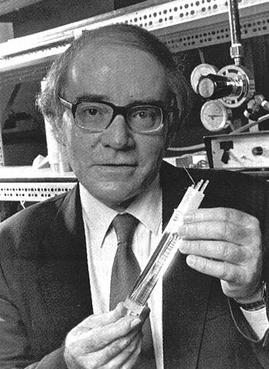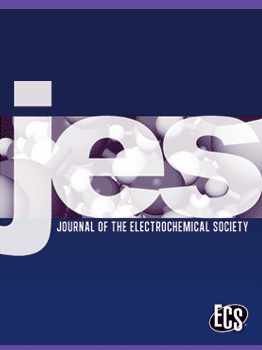The Electrochemical Society is a learned society based in the United States that supports scientific inquiry in the field of electrochemistry and solid-state science and related technology. The Society membership comprises more than 8,000 scientists and engineers in over 85 countries at all degree levels and in all fields of electrochemistry, solid state science and related technologies. Additional support is provided by institutional members including corporations and laboratories.

Joseph Wang is an American biomedical engineer and inventor. He is a Distinguished Professor, SAIC Endowed Chair, and former Chair of the Department of Nanoengineering at the University of California, San Diego, who specialised in nanomachines, biosensors, nano-bioelectronics, wearable devices, and electrochemistry. He is also the Director of the UCSD Center of Wearable Sensors and co-director of the UCSD Center of Mobile Health Systems and Applications (CMSA).

Allen Joseph Bard is an American chemist. He is the Hackerman-Welch Regents Chair Professor and director of the Center for Electrochemistry at the University of Texas at Austin. Bard is considered a "father of modern electrochemistry" for his innovative work developing the scanning electrochemical microscope, his co-discovery of electrochemiluminescence, his key contributions to photoelectrochemistry of semiconductor electrodes, and co-authoring a seminal textbook.

Martin Fleischmann FRS was a British chemist who worked in electrochemistry. Premature announcement of his cold fusion research with Stanley Pons, regarding excess heat in heavy water, caused a media sensation and elicited skepticism and criticism from many in the scientific community.

The Journal of Applied Electrochemistry is a peer-reviewed scientific journal published by Springer Science+Business Media covering electrochemistry, focusing on technologically oriented aspects. A major topic of the journal is the application of electrochemistry to technological development and practice. Subjects covered are cell design, electrochemical reaction engineering, corrosion, hydrometallurgy, the electrochemical treatment of effluents, molten salt and solid state electrochemistry, solar cells, new battery systems, and surface finishing.
Electrochemical engineering is the branch of chemical engineering dealing with the technological applications of electrochemical phenomena, such as electrosynthesis of chemicals, electrowinning and refining of metals, flow batteries and fuel cells, surface modification by electrodeposition, electrochemical separations and corrosion.

The Journal of the Electrochemical Society is a monthly peer-reviewed scientific journal covering the field of electrochemical science and technology. It is published by the Electrochemical Society. According to the Journal Citation Reports, the journal has a 2020 impact factor of 4.316.

The ECS Journal of Solid State Science and Technology is a monthly peer-reviewed scientific journal covering solid state science and technology. The editor-in-chief is Krishnan Rajeshwar. The Technical Editors are Francis D'Souza, Aniruddh Jagdish Khanna, Ajit Khosla, Peter Mascher, Kailash C. Mishra, and Fan Ren. The Associate Editors are Michael Adachi, Netz Arroyo, Paul Maggard, Meng Tao, and Thomas Thundat. The journal was established in 2012 and is published by The Electrochemical Society.

ECS Solid State Letters (SSL) is a peer-reviewed scientific journal covering the field of solid state science and technology. The journal was established in 2012 and is published by the Electrochemical Society. SSL ceased publication at the end of 2015. The editor-in-chief was Dennis W. Hess. According to the Journal Citation Reports, the journal has a 2014 impact factor of 1.162.

Electrochemical and Solid-State Letters (ESL) was a peer-reviewed scientific journal that began publication in 1998 as a joint publication of the Electrochemical Society and the IEEE Electron Devices Society. The final issue was published in 2012. The journal is now preserved as an archive, and has been replaced by ECS Electrochemistry Letters and ECS Solid State Letters.
Interface is a quarterly open access scientific journal published by the Electrochemical Society covering developments in electrochemistry and solid-state chemistry, as well as news and information about and for members of the society.

'Jose H. Zagal Moya is a Chilean scientist educated at the University of Chile with postgraduate training in the United States of America with a Ph.D. degree from Case Western Reserve University, Cleveland Ohio and postdoctoral training at Brookhaven National Laboratory, Upton, New York. At present he is a Distinguished Professor, Department of Chemistry and Materials, Faculty of Chemistry and Biology, Universidad de Santiago de Chile (USACH) where he directs the Laboratory of Electrocatalysis since 1982. He got his Ph.D. in chemistry Case Western Reserve University, US (1978) and was postdoctoral fellow at Brookhaven National Laboratory, Upton, New York, in 1982. His main research efforts are focused on the fundamentals of electron transfer reactions that are relevant for energy conversion and sensors. He has contributed in the area of electrocatalysis, electrodes modified with metal macrocyclics, electrochemistry of biological molecules, the catalysis of the reduction of molecular oxygen and many other reactions of relevance, conductive polymers, electrochemical sensors and in pioneering work in the establishment of non-linear correlations between thermodynamic properties of molecular catalysts and their electrochemical reactivity. These contributions are essential in the development of non-precious metal catalysts for energy conversion devices and electrochemical sensors. [1][2][3] He also has contributed in the field of corrosion, conductive polymers and his well-known volcano correlations for the electrocatalytic properties of surface-confined molecular catalysts

Andrzej Wieckowski was an Emeritus Professor of Chemistry at the University of Illinois at Urbana–Champaign and the North American Editor of Electrochimica Acta. He is known for his spectroscopic investigations of electrocatalysis in fuel cells and co-inventing of the direct formic acid fuel cell (DFAFC). He authored more than 300 publications, has been cited over 13,000 times and has an h-index 60. He was appointed fellow of the Electrochemical Society in 2007 and fellow of the International Society of Electrochemistry in 2009. He was awarded the US Department of Energy Prize for outstanding Scientific Accomplishment in Materials Chemistry in 1992, the ISE Jacques Tacussel Prize in 1998, the ECS David. C. Graham Award in 2003, and the ISE Gold Medal in 2007.
Alvin J. Salkind was an American chemical engineer. Salkind is known for writing the seminal texts Alkaline Storage Batteries with S. Uno Falk and making tremendous gains in the area of battery. Among his many scientific contributions, Salkind was the first to build a battery into an x-ray port tracking structure with state of charge. In 2005, Salkind was named to the College of Fellows of the American Institute for Medical and Biological Engineering. In 2014, he became a fellow of the Electrochemical Society.
Martin Winter is a German chemist and materials scientist. His research in the field of electrochemical energy storage and conversion focuses on the development of new materials, components and cell designs for batteries and supercapacitors, lithium ion batteries and lithium metal batteries.

Doron Aurbach is an Israeli electrochemist, materials and surface scientist.
Shelley D. Minteer is an American academic and chemistry professor at the University of Utah. Minteer field of study focuses on the interface between biocatalysts and enzyme-based electrodes for biofuel cells and sensors.
Viola Ingrid Birss is a Professor of Chemistry at the University of Calgary. She works on electrochemistry and the development of nanomaterials for sustainable energy and sensing applications. She has demonstrated a metal oxide perovskite that can be used as the air and fuel electrode in solid oxide fuel cells, as well as creating nanoporous carbon scaffolds to be used in batteries and capacitors.
Héctor Daniel Abruña is a Puerto Rican physical chemist whose work focuses on electrochemistry, molecular electronics, fuel cells, batteries, and electrocatalysis. Abruña is director of the Energy Materials Center and Emile M. Chamot professor for chemistry at Cornell University. He became a Fellow of the American Association for the Advancement of Science in 2006, a Member of the American Academy of Arts and Sciences in 2007, and a Member of the National Academy of Sciences in 2018. Abruña conducts research into battery and fuel cell systems using electrochemical techniques and X-ray microscopy and spectroscopy methods.
Gerardine "Gerri" Botte is a Venezuelan-American chemist who is a Professor and the Whitacre Department Chair in Chemical Engineering at Texas Tech University. Her research considers electrochemical engineering and the development of sustainable manufacturing processes. Botte is Editor-in-Chief of the Journal of Applied Electrochemistry and a Fellow of the Electrochemical Society.











